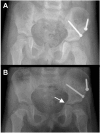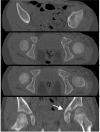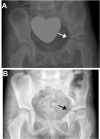Management of an open acetabular fracture in a skeletally immature patient
- PMID: 19461903
- PMCID: PMC2684707
- DOI: 10.2174/1874325000701010009
Management of an open acetabular fracture in a skeletally immature patient
Abstract
Background: Open acetabular fractures in children are rare, but potentially devastating injuries. Secondary to the low incidence, there is an apparent lack of reports on appropriate management strategies for open pediatric acetabular fractures in the literature.
Methods: Description of a case study.
Results: A 3 years and ten months-old girl was ejected as a passenger from an all terrain vehicle. She sustained a displaced, grade IIIA open left anterior column acetabular fracture. The injury was treated by extending the open wound to a formal first window of the ilioinguinal approach. After surgical debridement, the anterior column was reduced anatomically and fixed by two lag screws which avoided the tri-radiate cartilage. A vaginal laceration was debrided and repaired. The patient was treated in a spica cast without weight bearing on the left lower extremity for 8 weeks. No perioperative complications occurred. The acetabular fracture healed in an anatomic position within 8 weeks. To avoid premature closure of the tri-radiate cartilage, the patient underwent a physeal bar resection at one year after injury. At two-year follow up, she was walking and running without pain and had a free range of motion of her left hip.
Conclusions: Operative management should represent the therapy of choice for open, displaced pediatric acetabular fractures. After fracture healing, a scheduled physeal bar resection may be required for injuries which involve the tri-radiate cartilage.
Figures





Similar articles
-
Minimal invasive para-rectus approach for limited open reduction and percutaneous fixation of displaced acetabular fractures.Injury. 2014 Jun;45(6):995-9. doi: 10.1016/j.injury.2014.02.006. Epub 2014 Feb 15. Injury. 2014. PMID: 24613611
-
TENS for surgical stabilisation of acetabular fracture in the skeletally immature: A novel technique.Injury. 2021 Jan;52(1):90-94. doi: 10.1016/j.injury.2020.11.004. Epub 2020 Nov 2. Injury. 2021. PMID: 33168201
-
[Total hip arthroplasty for treatment of acute acetabular fracture in elderly patients].Rev Chir Orthop Reparatrice Appar Mot. 2007 Dec;93(8):818-27. doi: 10.1016/s0035-1040(07)78465-9. Rev Chir Orthop Reparatrice Appar Mot. 2007. PMID: 18166954 French.
-
External iliac artery thrombosis following open reduction of acetabular fracture: a case report and literature review.Arch Orthop Trauma Surg. 2020 Apr;140(4):481-485. doi: 10.1007/s00402-019-03288-3. Epub 2019 Oct 23. Arch Orthop Trauma Surg. 2020. PMID: 31642955 Review.
-
Surgical management of acetabular fractures - A contemporary literature review.Injury. 2020 Oct;51(10):2267-2277. doi: 10.1016/j.injury.2020.06.016. Epub 2020 Jun 24. Injury. 2020. PMID: 32646650 Review.
Cited by
-
Open acetabular fracture: Case report and literature review.Trauma Case Rep. 2019 Feb 15;20:100180. doi: 10.1016/j.tcr.2019.100180. eCollection 2019 Apr. Trauma Case Rep. 2019. PMID: 30815532 Free PMC article.
-
A modified stoppa (technique) approach for treatment of pediatric acetabular fractures.Case Rep Orthop. 2013;2013:478131. doi: 10.1155/2013/478131. Epub 2013 May 27. Case Rep Orthop. 2013. PMID: 23781368 Free PMC article.
References
-
- Heeg M, de Ridder VA, Tornetta P 3rd, de Lange S, Klasen HJ. Acetabular fractures in children and adolescents. Clin Orthop Relat Res. 2000;376:80–6. - PubMed
-
- Schlickwei W, Keck T. Pelvic and acetabular fractures in childhood. Injury. 2005;36(Suppl 1):A57–63. - PubMed
-
- Rieger H, Brug E. Fractures of the pelvis in children. Clin Orthop Relat Res. 1997;336:226–39. - PubMed
-
- Rubel IF, Kloen P, Potter HG, Helfet DL. MRI assessment of the posterior acetabular wall fracture in traumatic dislocation of the hip in children. Pediatr Radiol. 2002;32:435–9. - PubMed
-
- Smith WR, Oakley M, Morgan SJ. Pediatric pelvic fractures. J Pediatr Orthop. 2004;24:130–5. - PubMed
LinkOut - more resources
Full Text Sources
Miscellaneous
